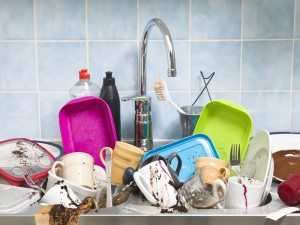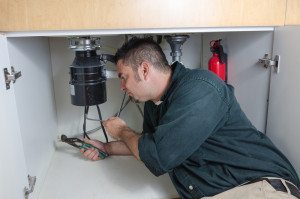Your garbage disposal may seem all-powerful, but like any other appliance, it has its weaknesses too. It’s easy to use and helps you avoid unpleasant odors in the trash, but as  convenient as it is, the disposal isn’t meant to handle every type of food. In fact, some items can damage your disposal, necessitating repairs or even replacement.
convenient as it is, the disposal isn’t meant to handle every type of food. In fact, some items can damage your disposal, necessitating repairs or even replacement.
Find out what you need to avoid putting down your garbage disposal to keep it running smoothly.
Grease and Grounds
Grease and oils may easily slide down the disposal, but fats distribute a greasy film over the blades, which makes them less effective. The grease and oil from foods also can solidify and build up in the pipes, resulting in clogged drains and expensive rooter bills.
Like grease and oils, coffee grounds seem to go down the garbage disposal quite well, and many homeowners rely on them to help eliminate sink odors. Over time, however, grounds can build up in the pipes like sediment, backing up the works and causing issues with the disposer’s function.
Fibrous, Stringy and Expandable Foods
Fibrous foods, including celery, corn husks, asparagus, leeks, carrot peels and onion skins can become wrapped around the blades of the disposal. This exerts resistance on the blades and prevents the motor from operating properly.
Similarly, the membrane on the inside of eggshells can wrap around the disposal blades, resulting in damage. Small amounts of these foods may not cause problems, if they are accompanied by strong stream of cold water before, during and after using the appliance. Whenever possible, just toss these troublemakers into the trash or compost pile instead.
Foods that expand when cooking, such as pasta, beans, rice and potato peels, also do not belong in the disposal. Even after being ground up, these foods can continue to absorb water, forming a paste-like substance that can clog the disposal and pipes.
Hard Foods and Non-Food Items
Though some people believe that occasionally grinding up certain types of hard materials can clean the walls and interior mechanisms of the disposer, these items actually can cause significant damage. A small chicken or fish bone or a few eggshells here or there may be fine, but any hard item such as the pits from peaches, plums, cherries, avocados and other stone fruits and berries can potentially wreak havoc as they bounce around in the disposal.
Non-food items are never appropriate for the garbage disposal. Cigarette butts, sponges, plant clippings, plastic, paper and other non-food materials cannot be broken down enough to wash them through the appliance and the drain. A good rule of thumb is that if you can’t eat it, neither should the disposal!
By following these simple tips, you can keep your hungry sink friend running smoothly and efficiently. If something does go wrong, Complete Appliance Repair is here for you. Contact us today for all of your home appliance sales, installation, maintenance and repair needs, including help with your garbage disposal.


 maintenance at any sign of trouble may help prolong the life of your unit. But, as with any appliance, you may want to consider replacement at some point. Following are some signs that now may be the time to think about purchasing a new disposal.
maintenance at any sign of trouble may help prolong the life of your unit. But, as with any appliance, you may want to consider replacement at some point. Following are some signs that now may be the time to think about purchasing a new disposal. performance levels whenever you need it.
performance levels whenever you need it.